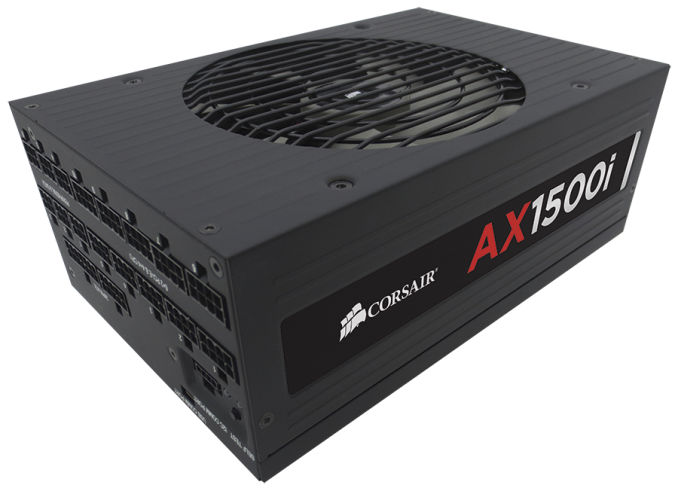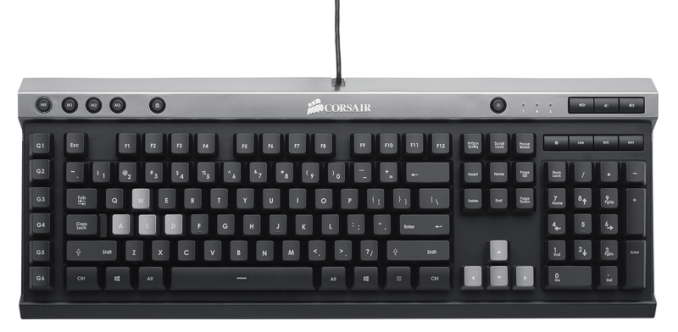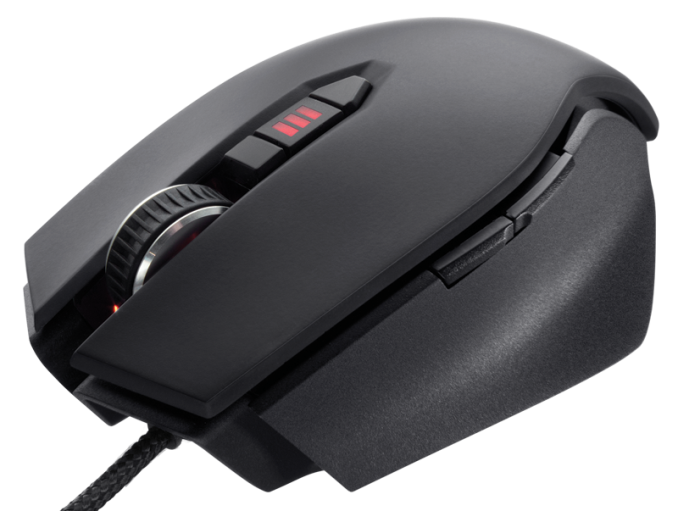Corsair Showcase a Technology Smörgåsbord at CES 2014
by Ian Cutress on January 7, 2014 12:00 PM ESTNew PSU: Corsair AX1500i Digital ATX PSU
Over recent years Corsair’s PSU business has been booming, at least in terms of how often I find them mentioned in new builds in online forums. Newegg and Amazon both have a wealth of reviews showing that Corsair has established itself as one of the main players. In recent quarters the push in the PSU market has been towards the digital – being able to manage and monitor how the power supply responds to load, as well as keeping logs of temperatures and how each rail and voltage line is performing are the new features. In order to bolster their digital AX line, currently occupied by the AX760i, the AX860i and the AX1200i, Corsair is releasing a higher end model – the AX1500i, rated at 1500W for 80 PLUS Platinum:
Corsair claims this is the world’s most technologically advanced and efficient PSU for PC enthusiasts, and that the unit will perform beyond the 80 PLUS Platinum standard – stating that if the Titanium standard for 230V (Europe and others) was available for 115V today and this unit was tested for it, it would receive that award instead (the spec is currently being drafted).
1500W is clearly a lot and most builds need not apply. I remember when testing a dual Xeon 32-thread workstation and four 7970s that drew 1550W when overclocked – that is the market that this power supply is aiming for. The AX1500i comes fully modular, and is configurable in both multi-rail and single rail format (users can set their own overcurrent protection limits) via Corsair Link. The PSU also uses a zero RPM fan mode, such that the power supply will not even spin its fan until the power draw exceeds 450W.
Aside from the 150 x 86 x 225mm dimensions and the 7-year warranty, the AX1500i will be available in Q2 at an MSRP of US$450.
New Keyboard and Mouse: Raptor K40 and Raptor M45
Many of the more traditional component manufacturers are coming out with their own line of peripherals – what used to be the home of companies like Logitech are now filled with GIGABYTE and Corsair-like brand wanting a piece of the action. This is all a good thing for consumers – competition breeds innovation, and for gamers, having the right equipment is only one piece of the puzzle. In that gamer element, after the PC, there are several other items that deserve a $50-$200 investment apiece: gaming mice, gaming keyboards, gaming mouse mats, gaming headsets, gaming chairs, gaming glasses, or even more expensive gaming monitors and so on.
To add to their Raptor lines, Corsair is ‘unleashing’ a new keyboard and mouse at CES.
The Raptor K40 is a non-mechanical (rubber-dome) keyboard with onboard macro storage, full-key rollover on USB, and the main selling point is the 16.8 million color customizable backlighting. This is a whole motherboard backlighting, rather than the per-key backlighting we saw with the Cherry MX RGB which allowed users to customize their gaming experience on a per-game basis. The macro features give six keys on the left hand side of the keyboard and three separate bank keys to adjust as necessary. The WASD and arrow keys are also in grey to differentiate from the rest of the black keys. Corsair are saying the K40 will be available in January with a two-year warranty and an MSRP of $80.
The gaming mouse debate is a long and exhaustive one – wired or wireless, large grip or small grip, adjustable DPI, optical or laser, how many macro keys, and so on. Back when I was clan gaming, I ran a wireless gaming mouse – I could not stand the wire being caught on the side of the table. Each to their own of course and this is why there are plenty of models in the market to cater for everyone: now the M45 from Corsair, continuing on from their M65 and M60, is coming out to play.
The right handed M45 starts with a Pixart PMW3310 5000 DPI optical sensor with a high-mass scroll wheel in a soft-touch housing. The rear has large PTFE glide pads and an adjustable weight system in order to get the responsiveness a user needs for their type of gaming. The buttons on the side are macro buttons, configurable through software, and the DPI is adjustable on top. The wired M45 should be available in January with a two-year warranty and an MSRP of $60.



















19 Comments
View All Comments
UltraWide - Tuesday, January 7, 2014 - link
Still not using spring-loaded screws... FAILJimmaDaRustla - Tuesday, January 7, 2014 - link
I see no spring-loaded screws???Aikouka - Tuesday, January 7, 2014 - link
As an owner of a 550D, 800D and 900D, the lack of a push-button side panel release on an Obsidian case is kind of odd to me. I'm guessing it's because of space given it requires a metal rail to handle the latching. Although, I have two questions about the 250D:1) Is there a "hidden" fan mount point on the top of the case? It looks very similar to the 550D's hidden panels that it uses on the top and side panel.
2) What size fans mounts are those above the I/O area? They look a little small, but I'm not sure if they're just 80mm. It's kind of funny because I remember when 80mm used to be normal, but now those look small given the prevalence of 120mm and 140mm fans.
Anyway, I'm curious about both of those because this case looks like it could be decent for an open-air GPU given the open vents on the side right by the GPU (I hope they include a magnetic filter), but you'd probably want some fans to help push out the heat from the GPU. Fans on the top or right by the I/O should help accomplish that.
Frozenlight - Tuesday, January 7, 2014 - link
Sadly, the thing at the top is a window.Aikouka - Tuesday, January 7, 2014 - link
Ah... that's a bummer. It didn't look exactly like the 550D's fan covers, but it looked a little too opaque in the photos to be a window.Dustin Sklavos - Tuesday, January 7, 2014 - link
There are no fan mounts in the top; there are two 80mm fan mounts in the back. Where I think it gets interesting (disclaimer: totally biased, work at Corsair as my day job) is that it supports a 240mm radiator in the side.extide - Tuesday, January 7, 2014 - link
Note, under the H105 section, you mention the H110 as being a 240mm design, while it is actually a 280mm design.Kevin G - Tuesday, January 7, 2014 - link
What would be news is Corsair reducing the number of series in their power supply line up. There is AX, AXi, CS, CX, GS, HX, RM, and TX series. Killing off a line or two and simplifying their portfolio would do wonders.I also want to see more Carbide Air series cases. I really like the look of it and appreciate its design philosophy but there is so much more potential I've been holding off of a purchase. It is soooooooooooo close to exactly what I want it is frustrating.
Dustin Sklavos - Tuesday, January 7, 2014 - link
What is it missing?Aikouka - Tuesday, January 7, 2014 - link
A few weeks back, I decided to drop water cooling and just go back to air cooling. I figured that I would give the Carbide Air 540 a shot since it has good reviews on its air cooling potential. However, after using the case, I simply cannot recommend it to anyone.1) The most egregious problem with the case is that it's way overpriced. The case feels cheap, which most likely stems from a lot of it being built out of molded plastic. What really got to me was that I also own an Obsidian 550D, which has the same MSRP, but it feels like it's leagues above the Air 540 in build quality and features. Also, I found that if you use some of the extra fan mount points on the 550D, the temperature differences are nearly negligible. You may say that the 550D also has a bit of plastic on it too, which is true. However, I think in this case, it's the plastic's shiny texture that's reminiscent of cheap $40 OEM cases and the flimsy side panel that make the Air 540 feel cheaper.
2) There is a serious design flaw in the rear case fan mounting. Now, as much as I dislike the detachable grill, that's not what I'm talking about. The problem is that the area is designed in such a way that you cannot properly use many different aftermarket fans -- including fans from Corsair! I originally ran into this problem because my rear fan came with a bad bearing (quality control has never been a strong suit). So, I went to put an AF140 in its place, but I realized that any fan with something in the area between the mounting holes would never fit because of a lip near the back.
I ended up purchasing a nice and quiet Enermax fan, but that wouldn't work for a completely different reason! It also turns out that you cannot use a fan with a square shape, because that blocks the side panel's top thumb screw from threading in all the way.
3) The 2.5" drive carriage doesn't hold 7mm drives (e.g. Samsung SSDs) well. To be fair, I have other third-party items that hold 2.5" drives that also don't work well with 7mm drives.
4) The placement of the hard drives is not terribly good for proper cooling. It's not much of a surprise that the 3.5" hard drive on the left ran 4-5C hotter than the one on the right.
5) Consider a single male SATA power connector for the two 3.5" drives. Although, a user can simply purchase a Y-cable and do this themselves.
If I had to rate the Corsair cases that I've owned, I would rate them: 550D > 900D > 800D > Air 540. I also think that the first two are leagues better than the latter two.